All posts by Antonio Gomez
DIY Roofing Repairs in San Jose
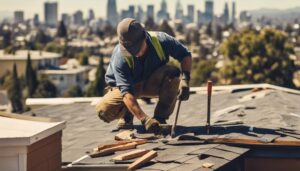
If you’ve noticed some wear and tear on your roof in San Jose, taking action on your own might be more feasible than you think. From evaluating the damage to gathering the necessary tools, starting a DIY roofing repair project can be both rewarding and cost-effective. However, before you grab your toolkit and head up, there are some important considerations to keep in mind to guarantee a successful outcome. Remember, a stitch in time saves nine, especially when it comes to protecting your home from the elements.
Roof Inspection
If you’re looking to assess the condition of your roof, a thorough roof inspection is essential for identifying any potential issues. Start by visually examining the roof from the ground, looking for missing, cracked, or curling shingles. Check for any signs of damage around the chimney, vents, or skylights. It’s important to also inspect the gutters for granules from the shingles, as this could indicate roof wear.
Next, climb onto the roof using a sturdy ladder. Walk carefully and check the roof’s surface for any soft spots or sagging areas, as these could signify underlying damage. Look closely at the flashing around chimneys and vents to make sure they’re secure and not rusted. Pay attention to any signs of water damage or mold growth, as these are indicators of leaks.
In addition to the visual inspection, it’s recommended to check the attic for any signs of water infiltration, such as stains or dampness. By conducting a thorough roof inspection, you can catch any potential issues early and prevent costly repairs down the line.
Safety Precautions
To guarantee your safety while inspecting your roof, always use a secure and stable ladder. Before climbing up, make sure the ladder is on even ground and ask someone to hold the base for extra stability. It’s important to wear appropriate footwear with good traction to prevent slipping. Additionally, consider using a safety harness or rope to secure yourself while working on the roof. Check the weather forecast before starting any repairs to avoid slippery conditions or strong winds that could compromise your safety.
When inspecting the roof, be mindful of overhead power lines and make sure you maintain a safe distance. Always be cautious of where you step to avoid weak spots that could give way. If you encounter any signs of structural damage, such as sagging or soft spots, don’t attempt to walk on those areas. Finally, never work on the roof alone; having someone nearby in case of an emergency is essential for your safety.
Materials Needed
Gather all the necessary materials for your roofing repairs to guarantee a smooth and efficient process. You’ll need replacement shingles that match the color and style of your existing roof. Make sure to have roofing cement or adhesive on hand to secure the shingles in place. Additionally, gather a utility knife for cutting shingles to size, a hammer for nailing them down, and a caulking gun for applying sealant. It’s also essential to have a ladder that reaches the roof safely and comfortably.
Don’t forget to equip yourself with safety gear such as work gloves, safety glasses, and sturdy shoes with good traction to prevent slips. If you’re working on a sunny day, consider wearing a hat and sunscreen as well. Have a broom or brush ready to clean up debris and a garbage bag for easy disposal. Lastly, keep a water bottle handy to stay hydrated throughout the repair process. With these materials prepared, you’ll be well-equipped to tackle your roofing repairs effectively.
Repairing Missing Shingles
Repairing missing shingles requires identifying the exact location of the damage before proceeding with any repairs. To effectively tackle this task, follow these steps:
1. **Safety First:** Before climbing onto your roof, make sure you have proper safety gear such as a harness, sturdy shoes, and a stable ladder.
2. **Inspect the Area:** Carefully examine the roof to locate where the shingles are missing. Look for any signs of damage or water leaks.
3. **Gather Materials:** Get the necessary replacement shingles, roofing nails, a hammer, and a pry bar to remove any remaining pieces.
4. **Replace the Shingles:** Carefully remove the damaged shingles and replace them with new ones. Ensure they’re properly aligned and securely fastened to prevent future issues.
Fixing Roof Leaks
When addressing roof leaks, identifying the source of the leak is essential for effective repairs. Start by inspecting the interior of your home for any water stains or mold growth on the ceiling or walls near the leak. Once you have pinpointed the general area of the leak, head up to the roof to locate the specific source. Check for damaged or missing shingles, cracked flashing around chimneys or vents, and any gaps in the roof where water could seep through.
If you find a damaged shingle, you can fix it by applying roofing cement underneath and on top of the shingle to secure it in place. For cracked flashing, remove the old caulk, apply new roofing sealant, and secure the flashing back into position. In case of gaps, seal them with roofing cement or silicone caulk. Remember to always prioritize safety when working on your roof, and if the repairs seem too complex, don’t hesitate to consult a professional roofer for assistance.
Clearing Gutters
Inspect your roof gutters regularly to make sure they’re free from debris and blockages, especially after addressing roof leaks. Clogged gutters can lead to water backup, causing damage to your roof and home.
Here are some tips to help you effectively clear your gutters:
1. **Use a sturdy ladder**: Make certain your ladder is stable and secure before climbing up to reach the gutters.
2. **Wear protective gear**: Put on gloves and safety goggles to shield your hands and eyes from dirt, debris, and potential pests.
3. **Remove large debris by hand**: Begin by scooping out leaves, twigs, and other visible blockages by hand and placing them into a bucket or trash bag.
4. **Flush the gutters**: After clearing out the larger debris, use a garden hose to flush out any remaining dirt and ensure proper water flow through the gutters and downspouts.
Regular gutter maintenance can prevent water damage and prolong the life of your roof.
Sealing Flashings
To effectively seal flashings on your roof, make sure that you use high-quality roofing sealant that’s compatible with the material of your flashings. Inspect the flashings for any signs of wear, cracks, or gaps that could potentially lead to water leaks. Before applying the sealant, clean the flashing area thoroughly to remove any dirt, debris, or old sealant residue that could prevent proper adhesion.
Using a caulking gun, carefully apply the roofing sealant along the edges and seams of the flashings, ensuring that there are no gaps or missed spots. Smooth out the sealant with a putty knife to create a uniform seal and prevent water from seeping underneath the flashings. Pay special attention to areas where the flashings meet other roofing materials or vertical walls, as these junctions are common entry points for water.
Once the sealant has been applied, allow it to cure completely according to the manufacturer’s instructions before exposing it to any moisture. Regularly inspect the sealed flashings for any signs of damage or deterioration, and reapply sealant as needed to maintain a watertight seal.
Patching Roof Holes
Maintain the integrity of your roofing by promptly addressing any holes that may compromise its integrity. When it comes to patching roof holes, taking quick action can prevent further damage and costly repairs. Here are four essential tips to effectively patch roof holes:
1. **Assess the Damage**: Start by inspecting the extent of the damage to determine the best course of action. Identify the size of the hole and any underlying issues that may have caused it.
2. **Gather Materials**: Before starting the repair, gather all the necessary materials such as roofing cement, roofing nails, and a patching material that matches your roof type. Having everything on hand will make the process smoother.
3. **Clean and Prepare the Area**: Remove any debris or loose materials around the hole. Make sure that the area is clean and dry before applying any patching materials to promote adhesion and effectiveness.
4. **Apply the Patch**: Follow the manufacturer’s instructions to apply the patching material over the hole securely. Smooth out the patch to create a seamless finish that will protect your roof effectively.
Applying Roof Coating
When applying roof coating, make certain that the surface is clean and dry for best adhesion. Start by clearing any debris or dirt from the roof. Use a broom or blower to make sure the surface is free of any loose particles that could affect the coating’s ability to adhere properly. Once the roof is clean, check for any existing damage that needs to be repaired before applying the coating.
Before you begin applying the roof coating, make certain to read the manufacturer’s instructions carefully. Different coatings may have specific application requirements, such as temperature conditions or drying times. Use a high-quality brush or roller to evenly apply the coating to the roof surface. Work in small sections to make certain thorough coverage and a smooth finish.
Once the coating is applied, allow it to dry completely before exposing it to foot traffic or adverse weather conditions. Regularly inspect the roof coating for any signs of wear or damage, and reapply as needed to maintain the roof’s protection.
Regular Maintenance
For effective upkeep of your roof’s condition, regularly inspecting for any signs of damage is essential. By staying proactive with maintenance, you can catch issues early on and prevent costly repairs down the line. Here are some key tasks to include in your regular roof maintenance routine:
1. **Clear Debris:** Remove any leaves, branches, or other debris that may accumulate on your roof, as these can trap moisture and lead to rot.
2. **Check for Leaks:** Inspect your attic for any signs of water intrusion, such as stains or dampness, which could indicate a leak in your roof.
3. **Trim Overhanging Branches:** Trim back any tree branches that are hanging over your roof to prevent damage from falling limbs and reduce the risk of moss or algae growth.
4. **Inspect Flashing:** Check the flashing around chimneys, vents, and skylights for signs of damage or deterioration, as these areas are common entry points for water.
Conclusion
To sum up, DIY San Jose roofing repairs are a cost-effective way to maintain the integrity of your roof and prevent costly damages.
By conducting regular inspections, implementing safety precautions, and using the right materials, homeowners can tackle common roofing issues effectively.
With proper maintenance and prompt repairs, you can extend the lifespan of your roof and guarantee a safe and secure home in San Jose.
Happy repairing!
When to Contact a Breckenridge CO Roofing Company
If you’re a tech-savvy homeowner, you might believe that some roofing jobs don’t require the presence of an expert, and that you can easily take care of them yourself. While this might be true in some cases, it’s often difficult to determine which ones. If you don’t want to end up having to cope with a damaged and partially repaired leaking roof when an impending storm is rapidly approaching, you might need to consider calling in your trusted Breckenridge CO roofing contractors as early as possible.

Emergency Roofing Support
Emergency roof repairs are some of the support solutions that dependable Breckenridge roofers can help you with the most. When your roof was damaged by a storm or suffered recent wind damage or fire damage, you have to act fast. When you call a Breckenridge roofer, they will arrive to the scene promptly, inspect the damage in record time, find out what’s wrong and already prepare several strategies for dealing with it promptly and efficiently.
Depending on your budget, they might suggest something like a quick fix for an older or poorly designed roof, until you manage to get the financing required to get it properly repaired or replaced. Alternatively, they might suggest an all-out plan in which they do some damage control at first, and then help you out with a full-scale roofing upgrade or restoration project.
Planning a Large Scale Renovation Project
Another time when you should consider contacting a professional Breckenridge roofer is when you need information or a detailed estimate on how much your roof repair or replacement project might cost. When you’re dealing with a large renovation project that includes siding replacement, fencing work, kitchen and bathroom remodeling and more, you’ll want to know how much you can spend from your budget on each particular part of the project.
Local Breckenridge roofing contractors can check on the work that needs to be done to remove the old roof, prepare or repair the underlying structure, and buy and install any new roofing materials or products that you might need. The cost can be pretty high when you include the labor, so accuracy if of paramount importance. Fortunately, that level of attention to detail is one of the aspects where Breckenridge CO roofers truly shine.
Should You Repair or Replace Your Roof?
Finally, it’s worth mentioning that repairs and replacement projects are both challenging to deal with, especially when you don’t exactly know which one to opt for. If you have an older roof, such as a metal roof that’s still sturdy but already more than 40-50 years old, then you might have to consider replacing it. That’s especially true when new repair jobs are no longer as efficient as they used to be.
Breckenridge roofing contractors have the expertise and experience to help you with that decision. As soon as you call them up, they will arrive on the premises and inspect your roof thoroughly to check for structural damage, and to determine whether or not the overall roofing structure can be salvaged. If not, they will present you with a few viable and practical options for affordable and efficient roofing designs that can act as a good replacement for your dated roof.
Top Recommendations for Roofing Materials on Frisco TX Homes
Roofing specialists always recommend roofing materials according to certain factors, one of the most significant being the local climate. That’s because there are different types of materials, on the market, some of them being more resistant than others in certain conditions. For example, there are roofing materials manufactured and tested to withstand high winds, others are better suited for cold climates with harsh winters and so on.
In Frisco, TX, the climate tends to be a bit more comfortable than in the rest of the state. Winters are rather mild, so there are not significant concerns regarding roof damage caused by heavy snow falls and freeze-thaw cycles.
Summers are hot though, so top recommendations for roofing materials on Frisco homes include those resistant to consistent sun exposure and temperatures over 100 degrees.
A fully exposed roof, with nothing around to protect it from the sun, can reach temperatures of up to 194 degrees F. If not properly ventilated, heat will build up, raising the temperature inside the house and causing condensation problems. In addition, you will keep the air conditioning on for a longer time, so you will pay higher energy bills.
But there are roofs that keep such problems at bay.

Here are some frequently recommended solutions by expert companies servicing residential and commercial roofing in Frisco TX.
Metal roofs
Metal roofs are naturally reflective. The reflection rating is based on the ability of the roof surface to reflect the sun’s rays. A cold roof, such as a metal roof, generally has a reflection of more than 65%, which helps to keep the building cool during the summer, lowering the cooling load and saving electricity consumption.
Asphalt shingles coated with reflective paint
There are reflective coatings approved by Energy Star, which help reduce heat transfer to the attic (and to the rest of the house). They can be applied even on ordinary asphalt roofs, prolonging their life, as the asphalt base will no longer age as quickly.
Green roofs
One way to prevent extreme temperatures and torrential floods in cities is to grow vegetated landscapes. Green roofs are an excellent example of the transformation of flat roofs into living roofs, capitalizing on both the economic and environmental benefits of green landscapes.
Green roofs are specially designed to be self-contained and easy to maintain; they are system adapted to our times, when people are becoming more and more concerned with protecting the environment and improving air quality. In addition, this type of roof best reduces the effect of urban heat island, during hot summers.
Solar roofs
A solar roof is obtained by installing a set of photovoltaic panels or, more recently, photovoltaic shingles. They are fixed to the roofs and terraces that cover and protect private or public buildings, being an excellent choice for Frisco, TX, which gets 230 sunny days per year. Sunroofs are the future of the present. These have countless benefits for the environment and your pocket, and are becoming more affordable as the technology behind them becomes more popular. Solar energy is free and available to us at any time, so solar roofs will definitely become more and more present, in the future.
How to Know If Your Castle Pines Home Needs a New Roof
Living in Castle Pines in Colorado can be a challenge when you consider the unpredictable amount of damage your home can sustain from a single storm. When you own an older roof, it will therefore be a challenge to even realize when your Castle Pines home might need a new roof and what factors to look for to avoid a disaster like your roof breaking down completely during a hail storm or thunderstorm.

What Could Affect Your Roof So Badly?
Castle Pines roofing often warrants of course a lot of maintenance work and occasional repairs. While Colorado in general is not necessarily a place where you’ll see a lot of rain – and the climate itself is quite dry – the weather challenges in the area can lead to your roof being significantly under risk.
Thunderstorms and hail storms can lead to water damage and impact damage on roofing systems that are not resilient enough – like those made primarily out of wood, asphalt or weaker metals. Also, Colorado has its fair share of snow in the winter, which can add to the weight of your roof and possibly even change its shape over time.
A lot of roofing problems in Colorado result from the dry weather. Flammable roofs are the ones that are most vulnerable from that standpoint, since occasionally the risk of dry wood and other flammable materials catching fire in Colorado will be significantly increased. As a result, Castle Pines roofing experts urge homeowners to consider materials that are fire-resistant or fireproof, such as metal, slate and clay.
Other issues also result from dryness, including wide temperature changes in the summer and winter which can especially affect certain metal roofing products that contract and expand more due to the changes in heat exposure.
Deciding on Roof Replacement
Considering all of these factors, it’s not too difficult to figure out how you can tell if your Castle Pines home needs a new roof. Depending on the material, there are various stressors that could affect your roof, such as the dry summers and winters, the hail or the thunderstorms. By doing some research on these stressors and on the structural durability of your roof over time, you can judge whether or not your roof has to be replaced even just based off of knowing how old it is.
For example, having a wooden roof that’s close to the end of its life as the summer is approaching can be a clear indicator that you need a new roof – preferably made from a material that isn’t flammable. Another example would be having an old metal roof that is no longer up to standard and requires more and more repairs every year. At one point, due to storms, temperature changes or other stressors, your metal roof might become too expensive to fix to warrant further repairs. At that point, you simply have to call on your trusted local roofers and have your roof replaced.
Birdie Roofing is one of the most dependable and advanced roofing companies operating in the Castle Pines area. Simply calling them up to ask them to take a look at your roof will be enough to get the best experts in the Colorado area on the case, so you’ll know exactly when it’s time for your roof to finally be replaced.
How Longmont Roofing Companies Can Handle Your Roof Repairs
There are many reasons for roof repair and Longmont roofing companies can efficiently help with all and any of them. Whether you need minor repairs, such as the replacement of a shingle or of some tiles on your roof, or a major intervention, such as the replacement of structural elements or even or an entire roof, local Longmont roofing companies will help you with timely interventions to restore the strength and the attractive appearance of the roof. Here is what the process involves.
Your Homework: Finding the Right Roofer
There are several steps that you need to complete before you hire a roofer. First of all, you need to identify the roofers available in your area and you will need to pick three or four of them based on criteria of legal operation, experience and the services offered.
Roofing is complex trade that includes the repair, maintenance, installation and replacement of various roof types and a wide array of materials. Given this complexity, most roofers specialize in certain materials and roof types – while some of them handle only pitched roofs, others specialize in low-sloping structures and most roofers also limit the types of materials that they handle. To ensure the success of your roofing project, you need local Longmont roofers that have vast experience in handling the type of roof that you have as well as the material that your roof is made from.

Another very important thing to check before a roofer is the contractor’s license to provide roofing services and their insurance policies. To be allowed to provide roofing work legally, contractors need to have a state-issued license and they also need to carry at least a general liability insurance and a worker’s compensation insurance.
The next step in finding the right Longmont roofer is to request written cost estimates from three or four roofers and to compare the documents in terms of the service range included, the quality of the materials to be used, the warranties offered and the final price. Ideally, the roofer should handle the disposal of any waste generated during the roof repair, so check the estimates based on that aspect as well.
What the Repair Process Will Involve
Your roofer will, first of all, assess the condition of the roof (this phase usually takes place before the roofer provides the roof repair cost estimate), then the contractor will discuss the repair options with the client. The contractor that you choose based on the process described above will return on their own or with their team to perform the repair. The process will involve the preparation of the repair site, the delivery of the roofing materials necessary for the repair (if any), the repair work itself and the cleaning of the job site, usually followed by the disposal of the waste generated during the repair work. While the roof preparation and repair are the roofer’s responsibility entirely, the client might also need to participate, moving their vehicles out of the way and covering any sensitive vegetation that might be damaged during the roofing work.
Typical Situations Where A Roof Replacement Might Be Necessary

The decision whether roof repair is the best course of action or roof replacement is the only solution is obvious in some cases, but difficult to make in others. In the case of a roof that has been devastated by a recent storm or that has started sagging after all the pressure it was exposed to because of the snow that has just melted, complete replacement is the only solution, but roofing issues that can only be solved through replacement can take other forms as well. Here are some typical situations that warrant a roof replacement.
The Roof Is Approaching the End of Its Lifespan
No roof lives forever, not even the best maintained ones in mild climates. Roofing materials are warranted for a specific period of time. Asphalt shingles, for example, can provide adequate protection for about 20 years, metal roofs can last for up to 50 years, while clay and cement tiles can stay on the building for over 70 years. If the material that your roof is made from is approaching the end of its lifespan, it is a good idea to start preparing for the replacement of the roof, even if the structure seems strong and stable.
Signs of Extensive Visible Damage
While a couple of cracked tiles or a damaged shingle can be easily replaced, if the damage is more extensive and it affects a significant part of the roof, replacement is the best solution. A great company that does roof repair near me says that the same goes for compromised structural components – if you see any sagging on your roof, you should start arranging for the replacement before the roof collapses.
An Unstoppable Succession of Roof Leaks
Every roof can start leaking, but if the roof is sufficiently strong, the leak is easy to fix. However, if you hardly fix a leak when a new one appears and you need to have buckets at hand whenever rain is announced in the forecast, the problem might be caused by a general weakening of the roof that can only be solved with complete roof replacement.
The Appearance of Ice Damming
Ice dams are caused by unwanted heat exchange between the building interior and the area right under the roof. The problem can sometimes be corrected by installing insulation under the roof, but if it is caused by structural issues or gaps in the roofing surface, a contractor that does roof repair near me confirms that roof replacement is the owner’s best option.
Critter Attacks
While any property with a garden gets animal visitors sometimes and many homeowners consider squirrels and birds to be cute guests, there are many other critters that can cause lots of damage in the house, especially if they move into the roofing structure. Wasps can build large nests and are notoriously difficult to get rid of, while termites can move in noticeably and when they do, they cause irreparable damage to the wood components of the house before they are detected. In extreme cases, there is no way to repair a roof that has become the victim of such harmful pests, the only solution being roof replacement.
How Do You Waterproof A Flat Roof?
Flat roofs are very resistant, durable, easy to install, to maintain and to repair and they are also more affordable than pitched roofs because they require less material than sloping structures. However, any structure has its downside, too – when it comes to the weak point of flat roofing systems, it is water ponding. Fortunately, there are several great ways to ensure that your flat roof sheds water with maximum efficiency – here are some.
Pay Special Attention to the Drainage System
Every roof needs gutters and downspouts to drain the water that the roof comes into contact with during rainy or snowy periods. Having an efficient draining system is especially important for flat roofs – the flatter a structure, the more reduced its ability to drain on its own, so the gutters attached to your flat roof needs to be designed and installed correctly to ensure roof health.
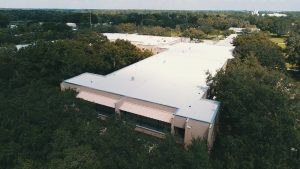
Choosing the Right Roofing Materials
The materials that your roof is made from is also essential for ensuring proper roof performance. Seamless solutions, such as the roofs that use single-ply or modified bitumen and built-up roofs, use a contiguous surface that is less prone to developing leaks and other issues caused by prolonged contact with moisture.
Regular Roof Maintenance
Having your roof regularly maintained by professional Orlando commercial roofers is another way to ensure that the roof is safe from water damage. If performed twice a year, once in spring and once in fall, professional maintenance can ensure that any damage is revealed when still small – the process should involve cleaning for the roof surface and the gutters and detailed inspections to find problems. Any issue detected should be fixed right away.
Get the Roof Inspected after Each Storm
Strong storms can damage even the best-kept, strongest roof, so it is a good idea to get your flat roof inspected after each major storm. Getting a professional to handle the task for you is very important because minor storm damage can be hard to notice, but most forms of roof damage progress very quickly and can turn into a major roof fault almost overnight if they are not addressed in a timely manner.
Roof Coatings
Whatever material your flat roof is made from, you can further enhance its water-resistance with the help of waterproof coatings. These coating products are like thick paint and they are also applied like paint, with the help of brushes, rollers or spray cans. The coating then forms a contiguous, water-resistant layer that seals the roof surface in front of water and increases its durability. It is a good idea to use an UV-resistant coating as well – solar radiations can be harmful for any roof surface, making the topmost layer of your building more sensitive to leaks, but you can prevent all that harm with the right coating.
Roof coatings can provide adequate protection for your roof for up to a specific number of years, so you need to make sure that the coatings are reapplied at the intervals specified in the product manual.
What To Budget For Your Commercial Roof Installation
Budgeting for your new commercial roof is among the most important tasks that you will need to handle while planning for the installation. The task is surely complex and comes with huge responsibility, so here are some important aspects to have in mind for more accurate cost calculations.
Start with Some Research of Your Own
A good commercial roof is not just any roof that fits into your installation budget – it is a roof that can stand up to the challenges specific for your climate area and that provides the longevity and the protection that you need. Not all roofing materials are suitable for any climate area and not all of them have the same lifespan, so start researching the materials used on commercial facilities considering these functional aspects. Try to familiarize yourself with all roofing components – find out about the layers that the type of roof that you have consists of as well as about the most typical materials used with each layer. Research adjacent components and systems, such as the drainage and the ventilation system as well and don’t forget about insulation either – these accessories are just as important as your roof’s support structure and the materials used for the surface.
Shop around to Get a General Idea about the Prices
Commercial roofing materials vary in terms of pricing as well and the task of finding the best deal is further complicated by the fact that each seller of building materials practices different pricing. When you already have an idea of the materials that might work well on your building, start checking the prices. Start with the construction material sellers in your area, but check the prices offered by online sellers and by manufacturers as well.
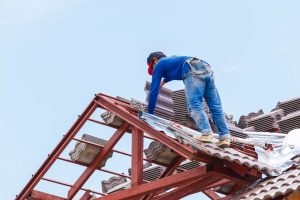
Shop around for the Right Roofer
To have a roof that provides durable protection for your business, you need not only good materials, but a good Aurora commercial roofing contractor to install them, too, so your roof installation budget will need to include labor-related costs as well. The strategy you should use for finding that contractor should involve the identification of the roofers available in your area, checking their experience, reputation and references, followed by contacting the roofers for cost estimates. Collect cost estimates from at least three or four roofers and compare the documents in terms of the services provided, the warranties, the materials used and the deadlines.
Expect the Unexpected
We all want our building remodeling or renovation projects to go exactly to plan, but unfortunately that rarely happens. Delays and hindrances are more likely in the case of projects that involve work done outdoors, like roof installation and all those delays and hindrances are likely to cost you money. To cover for those costs, Aurora commercial roofing pros suggest that you should set aside an extra budget of around 10% of your entire roofing budget – that amount should be enough for extra material costs, transport fees, extra laborers and other, similar expenses. If your roof installation goes smoothly, to plan, you will be able to use your safety budget for other upgrades.
The Range of Prices for Various Commercial Roof Installations
Flat roofs have become an architectural solution associated with most commercial buildings, although they are increasingly common in residential homes – modern and minimalist.
Unlike a traditional sloped roof, a flat roof involves lower costs and a more efficient use of the space, which justifies their popularity as commercial roofs. In addition, such a surface allows the installation of a green roof, a garden, a terrace, as well as the installation of solar panels.
In the case of flat roofs, thermal insulation and waterproofing are the most important aspects. As the water does not drain naturally, as in the case of sloped roofs, the construction must be protected. Good waterproofing for such a commercial roof means a safe building for your business.
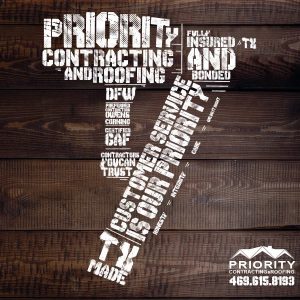
Given that any roof repair or reconstruction work is somewhat unique in its own way, Dallas commercial roofing company contractors will provide you with a work estimate after gathering sufficient information about your roofing project, following an on-site inspection.
The choice of waterproofing, as well as the manufacturer are extremely important, considering that the efficiency and durability of the project depend directly on them. In the situation where you have to choose a commercial roof cover, you have to consider a series of extremely important aspects such as:
- Durability – is an essential element for waterproofing the roof of a building because a durable roof is more effective in avoiding damage caused by water infiltration. The durability of a commercial roof must be comparable to the life of the building.
- Type of membrane – the roof waterproofing is made with the help of a membrane, and the durability and efficiency of the waterproofing depend on the properties of this membrane.
- Elasticity – it is important that the material from which the commercial roof is made be elastic and durable so that the roof remains efficient over time. It is advisable to opt for materials with properties that are not influenced by very low or very high temperatures.
- Installation – A commercial roof must be installed by a team of professional roofers. This is another extremely important element for the overall efficiency of the roof. Expert roofers can carry out the project according to the manufacturer’s instructions, they guarantee the durability of the project as well as its efficiency and stand behind their work.
The calculation of the price for a commercial roof installation is made taking into account a series of aspects such as:
- Materials
The majority share in the cost of a commercial roof project is represented by the materials, which are calculated depending on each project. These materials include membranes, adhesives, primers, etc. It is recommended that the estimate of the necessary materials be made by specialized personnel.
- Roof surface and geometry
Before contacting a manufacturer or distributor, you must get the correct roof dimensions. You will be able to receive an estimated price, but it will be substantially influenced by the type and quantity of materials and accessories you will need.
Never make a decision just considering the price per square meter of a certain material, if you do not want to have unpleasant surprises in the end! A visit from a specialist on site is what you need for a complete and correct estimate.
- Roof installation
Get price estimates from different roofing contractors and compare them.
Should I Do My Own Roof Repairs?
Roof repairs are scary for some homeowners, enjoyable and rewarding for others, so whether you should handle the repairs that become necessary on your roof depends on the complexity of the task and your skill level. While most roofing Houston TX contractors don’t recommend DIY roof repairs and they warn homeowners about the dangers of moving at heights as well as about the harm potentially caused by improperly and unprofessionally executed roof repairs, you can perform smaller repairs if you fulfill the following conditions.
You Possess the Know-How
Roof repairs, even small ones, can be performed properly only if you have the knowledge related to the procedures, the materials and the tools involved, so don’t attempt any repairs if you lack that knowledge.
You Can Do the Repair Safely
Roof repairs involve moving around at heights, so attempt the repair only if you feel comfortable up there on your roof and you possess the right gear. Whatever type of repair you are preparing to do, you will need a sturdy, stable ladder that can be safely attached to the roof edge, a proper fall-arrest system that allows you to anchor yourself safely while performing the repair and you will also need to wear the right clothes, including non-slip boots, a helmet and a good pair of work gloves.
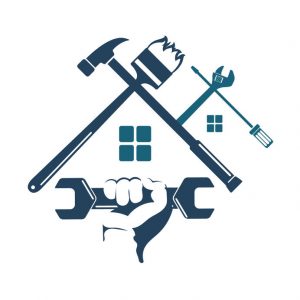
You Possess the Tools and the Materials
Familiarize yourself with the repair procedure as well as with the tools and materials that you will need. Prepare everything and figure out how you will take all the tools and materials up on the roof to have them all at hand before you start the work.
The Weather is Right
No roof repair can be performed when the weather is too hot or too cold, when the it is raining or snowing and when the wind is blowing too hard. Pick a day when the sky is a bit clouded, but the air is dry and comfortably warm.
Mistakes to Avoid
Roof repair involves not only physically demanding work, but attention to details as well. Here are some seemingly small DIY roof repair mistakes that can cost you a lot to remedy later:
- Improperly used fasteners – roofing nails that have the heads exposed to the elements, nails of the wrong size or not driven in completely can cause new leaks to appear;
- Superficial repairs – many DIY repairs address only the issue that is noticeable on the roof surface and fail to solve the problems that affect the deeper layers of the roof, such as the underlayment. When you repair your roof, pay attention to the signs of damage on the wooden structure of your roof as well.
Aspects Related to Your Roofing Insurance
Most roof insurance policies will not cover the roof owner for any damage caused by improper installation and repair performed by an unlicensed person, so if you make a mistake during your DIY repair, you are likely to lose the possibility to file a roofing claim if your roof suffers any damage because the quality of your work does not fulfill the conditions laid out in your insurance policy.
The best policy is to use roofing Houston TX contractors for all your roofing service needs.
